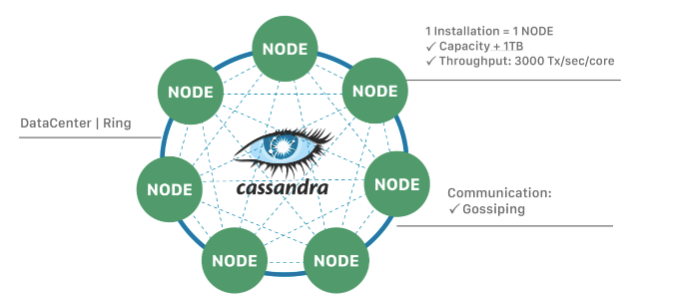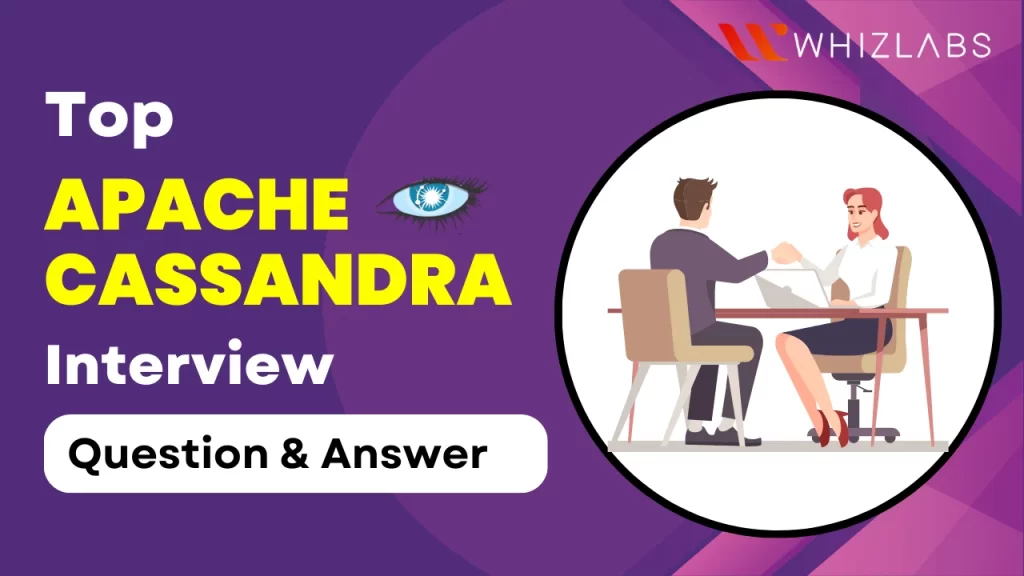Cassandra, a distributed database, is renowned for its high scalability and proficiency in handling significant volumes of structured data. To excel as an Apache Cassandra xpert, a solid understanding of its concepts, coupled with thorough training, is imperative. Enhancing technical skills and mastering the intricacies of the subject are vital.
In this blog post, we have presented important Cassandra interview questions and answers tailored for both fresher and experienced candidates, serving as a valuable resource to help secure their desired jobs.
Top Apache Cassandra Interview Questions and Answers
Here, we are going to address some commonly asked Apache Cassandra interview questions:
1. What is Apache Cassandra?
Cassandra is a NoSQL distributed database management system introduced by Apache. Cassandra is an open-source system designed to store and manage massive amounts of data without any failure. It is highly scalable for Big Data models and Facebook designs it.
Apache Cassandra has been built using the Java flexible schemas and it has no single point of failure. There are various types of NoSQL databases available but Cassandra is a hybrid of column-oriented and key–value store databases. The keyspace refers to the outermost container for an application, and the entity refers to the table or column family in Cassandra.
Here’s the Cassandra architecture:

2. What are the applications of Cassandra?
Cassandra proves versatile across various applications. Here are scenarios where choosing Cassandra is particularly advantageous:
- Messaging Services
Cassandra excels as a database for companies in the mobile phone and messaging services sector due to its capacity to efficiently handle substantial amounts of data.
- High-Speed Data Applications
For applications dealing with high-speed data influx from diverse devices or sensors, Cassandra’s ability to manage rapid data streams makes it an excellent choice.
- Retail Apps and Product Catalogs
Numerous retailers leverage Cassandra for robust shopping cart management and swift handling of product catalog data, ensuring durability and speed.
- Social Media Analytics and Recommendation Engines
Online companies and social media providers benefit from Cassandra as a reliable database for analytics and recommendation engines, enhancing their ability to analyze user behavior and provide personalized recommendations.
3. Explain Apache Cassandra vs Traditional Databases.
Cassandra and RDBMS differ significantly in their architecture, data handling, and scalability. Here are some key differences between them:
| Cassandra | RDBMS |
| High-performance and highly scalable NoSQL DBMS | Designed for relational databases |
| NoSQL database | Uses SQL for querying and maintenance |
| Deals with unstructured data | Deals with structured data |
| Flexible schema | Fixed schema |
| Peer-to-peer architecture with no single point of failure | Master-slave core architecture (single point of failure) |
| Handles high-volume incoming data velocity | Handles moderate incoming data velocity |
4. Explain the features of Cassandra.
Cassandra offers a multitude of exceptional technical features that contribute to its widespread popularity.
Here are some key attributes of Cassandra:
- High Scalability
Cassandra’s highly scalable nature allows the seamless addition of hardware to accommodate more customers and data as needed.
- Rigid Architecture
With no single point of failure, Cassandra ensures continuous availability, making it suitable for business-critical applications that demand uninterrupted operation.
- Fast Linear-scale Performance
Cassandra’s linear scalability enhances throughput by enabling the expansion of the cluster with additional nodes, maintaining a quick response time.
- Fault Tolerance
Demonstrating fault tolerance, Cassandra ensures data availability even if a node within a cluster becomes non-operational. Data redundancy across nodes safeguards against potential failures.
- Flexible Data Storage
Cassandra supports various data formats, including structured, semi-structured, and unstructured. It allows dynamic changes to data structures based on specific requirements.
- Easy Data Distribution
Cassandra facilitates straightforward data distribution by offering flexibility in replicating data across multiple data centers, ensuring efficient and customizable data placement.
- Transaction Support
Cassandra supports essential properties like Atomicity, Consistency, Isolation, and Durability (ACID), providing a reliable foundation for transactional operations.
- Fast Writes
Engineered to operate on cost-effective commodity hardware, Cassandra excels in delivering exceptionally fast write performance, capable of storing extensive data volumes without compromising read efficiency.
5. How does Cassandra store data?
In Cassandra, the data are stored in the form of bytes. By specifying the validator, the stored bytes will be encoded as per the requirement. The comparator order column is based on the ordering specified for encoding.
A composite in this context is essentially a byte array encoded with a specific format. Each component within the composite stores a two-byte length, followed by the byte-encoded component, and concludes with a termination bit.
6. What is meant by CQLSH? And why is it used?
Cassandra CQLsh stands for Cassandra CQL shell and it is used to specify how to use Cassandra commands. After the successful installation, Cassandra uses a prompt known as Cassandra query language shell (cqlsh). This command helps the users to communicate with the Cassandra
With the help of Cassandra CQLsh, you can:
- Define a schema
- Insert data, and
- Execute a query
It can be used on Linux or Windows and executes CQL commands such as ASSUME, CAPTURE, CONSISTENCY, COPY, DESCRIBE, and much more.
7. What are Clusters in Cassandra?
The outermost structure in Cassandra refers to the cluster. A cluster is a container for Keyspaces. Sometimes it is referred to as a ring because Cassandra assigns the data to nodes in the cluster in a ring format. A node holds a replica for varied data ranges.
8. List out the database components of Cassandra.
The core components in the Cassandra Architecture such as:
- Node
- Data Center
- Cluster
- Commit log
- Mem-table
- SSTable
- Bloom Filter
9. What is Memtable in Cassandra?
Cassandra writes the data in structured memory is termed a Memtable. It has an in-built cache for storing the content in the form of a key or column. With the help of key Memtable, sorting of data happens. There will be a separate Memtable for the column family and it holds the column data from the key.
10. What are partitions and Tokens in Cassandra?
Partition: It functions as a hash function present on every node, converting designated values in rows being added into tokens. This process transforms a variable-length input into a fixed-length value.
Token: An integer value produced by a hashing algorithm, serving to identify the location of a partition within a cluster.
11. What are the different types of Partitioners in Cassandra?
Cassandra offers the partitioners as listed below:
- Murmur3Partitioner (default): It distributes data across the cluster uniformly based on MurmurHash hash values.
- RandomPartitioner: It distributes data across the cluster uniformly based on MD5 hash values.
- ByteOrderedPartitioner: It keeps an ordered data distribution lexically with the help of key bytes
12. How does Cassandra perform write operations?
The write operations in Cassandra can be done via three components such as:
- Commitlog write
- Memtable write
- SStable write
Cassandra first writes data to a commit log and then writes into an in-memory structure Memtable and finally in SStable.
13. What is Cassandra- CQL collections?
In Cassandra’s CQL (Cassandra Query Language), collections allow you to store multiple values in a single variable. There are three main types of collections in CQL: List, Set, and Map.
- List
Used when preserving the order of data is important, and you need to allow duplicate values. It holds a list of unique elements.
- Set
Used for a group of elements where the order is not significant, and you want to enforce uniqueness. It holds repeating elements but ensures each element is unique.
- Map
It is used to store key-value pairs of elements. Each element in the map consists of a key and an associated value.
14. Explain the CAP Theorem.
The CAP theorem, also known as Brewer’s theorem, states that in a distributed computer system, it is impossible to simultaneously achieve all three of the following properties:
Consistency
- All nodes in the distributed system see the same data at the same time.
- In other words, every read receives the most recent write.
Availability
- Every request to the distributed system receives a response, without a guarantee that it contains the most recent version of the information.
- The system is always operational and responsive.
Partition-tolerance
- The system continues to operate even when network partitions occur, meaning communication between nodes is lost or delayed.
According to the CAP theorem, a distributed system can prioritize two out of the three properties, but it is impossible to achieve all three simultaneously.
15. Explain the concept of Bloom Filter.
A bloom filter is a compact data structure designed for efficiently checking whether an element belongs to a set. In practical terms, it helps determine if an SSTable (Sorted String Table) contains data for a specific row. In Cassandra, this is particularly useful for optimizing Input/Output (IO) when carrying out a key lookup.
16. What are the benefits of using Cassandra?
Apache Cassandra stands out from traditional databases by offering near real-time performance for Developers, Administrators, Data Analysts, and Software Engineers.
It employs a peer-to-peer architecture, eliminating the risk of a single point of failure seen in master–slave setups. This architecture allows seamless scaling with the addition of nodes, and any client can direct requests to any server.
Cassandra ensures extensible scalability, enabling easy adjustments to cluster size without restarting, and it excels in high-throughput read and write operations.
Notably, Cassandra’s robust data replication across nodes ensures data availability even in the face of node failures. Users can specify the number of replicas for added resilience. It is the preferred NoSQL database for handling massive datasets due to its outstanding performance.
Operating on a column-oriented structure, Cassandra accelerates data slicing and simplifies access and retrieval.
Moreover, its schema-free/schema-optional data model provides flexibility by eliminating the need to define all columns upfront, making it a versatile choice for various applications.
17. Define tunable consistency in Cassandra.
Cassandra’s tunable consistency is a standout feature, making it a top choice for Developers, Analysts, and Big Data Architects. Consistency, ensuring synchronized data across replicas, is customizable in Cassandra, offering two options: eventual consistency and strong consistency.
Eventual consistency guarantees synchronization once no new updates occur on a data item, achieving replica convergence over time.
On the other hand, for strong consistency, Cassandra follows the condition
R + W > N
where N is the number of replicas
W is the nodes required for a successful write
R is the nodes needed for a successful read
This flexibility empowers users to choose the consistency level that aligns with their specific use cases.
18. What is the replication factor in Cassandra?
The replication factor is a metric indicating the number of copies of data in a system. Increasing the replication factor is crucial for logging into the cluster.
19. What is SSTable? How is it different from other relational tables?
SSTable stands for ‘Sorted String Table’ and represents a vital data file in Cassandra. It accepts regularly written memtables, storing them on disk for each Cassandra table. SSTables exhibit immutability, meaning no further addition or removal of data items is allowed once written. Each SSTable in Cassandra is associated with three distinct files: a partition index, a partition summary, and a bloom filter.
20. What is the Cassandra Data Model?
The Cassandra data model comprises four primary components:
- Cluster
It is composed of multiple nodes and keyspaces.
- Keyspace
A namespace that organizes multiple-column families. Typically, there is one keyspace per partition, providing a logical grouping of related data.
- Column
It consists of a column name, a corresponding value, and a timestamp. It represents the basic unit of data storage in Cassandra.
- Column Family
It comprises multiple columns with references to a common row key.
Conclusion
I hope these Cassandra Interview Questions helped you to brush up your knowledge of Apache Cassandra. Take the Cassandra tutorial available online to explore in-depth concepts of Cassandra.
Reviewing these questions is recommended to familiarize yourself with the concepts and insights of Cassandra, which will assist you in preparing for your interview. To explore Apache Cassandra in real-time settings, explore our hands-on labs and sandboxes.
- AWS Security Specialists: Essential in Modern Cybersecurity - August 16, 2024
- Cloud Developer Tools Showdown: AWS vs Azure vs GCP - August 14, 2024
- Master AWS Lambda and API Gateway for Application Development - August 6, 2024
- Benefits of AWS Developer Associate Certification which Can Boost Your Career - July 24, 2024
- Preparation Guide on Datadog Fundamentals Certification - July 17, 2024
- What is DLP in Power Automate? - June 5, 2024
- Top Data Engineering Certifications in 2024 - May 30, 2024
- How Difficult is Google Cloud DevOps Engineer Certification? - May 29, 2024



